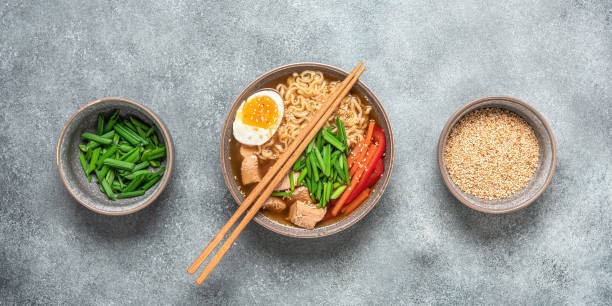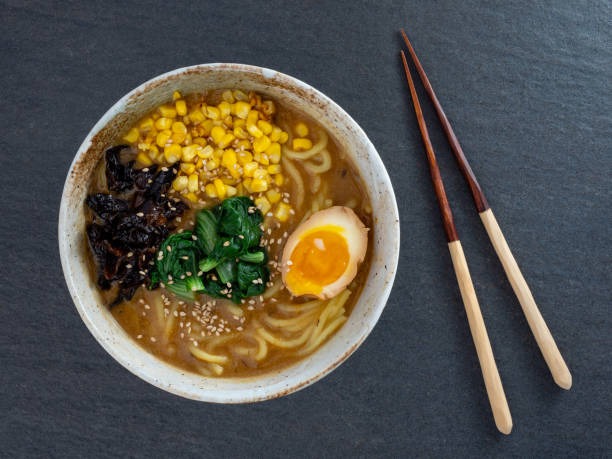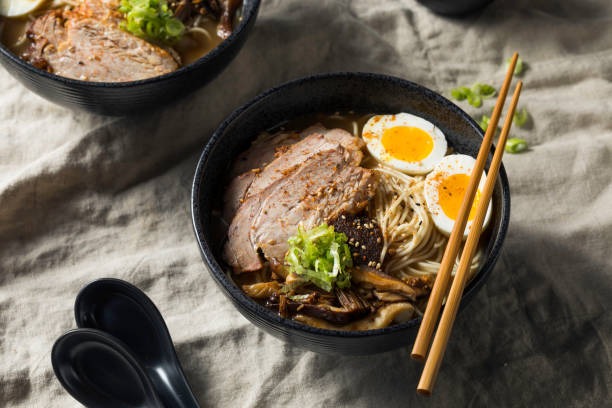Why Miso Ramen Is Everyone’s Comfort Food
Picture a steaming bowl of miso ramen, its rich broth swirling with umami, chewy noodles, and vibrant toppings, warming you from the inside out. This Japanese dish has captured hearts worldwide, blending tradition with modern flair. Whether you’re a ramen newbie or a noodle fanatic, miso ramen’s bold flavors and cozy appeal make it a must-try. Let’s dive into its magic and learn how to bring it to your kitchen.
What Is Miso Ramen?
The Essence of This Iconic Dish
Miso ramen is a Japanese noodle soup featuring a broth made from miso paste, a fermented soybean product, combined with ingredients like dashi, soy sauce, and aromatics. Paired with springy ramen noodles and toppings like pork, seaweed, and green onions, it’s a hearty, umami-packed meal. Originating in Hokkaido, it’s now a global favorite for its rich, savory depth.
Why Miso Makes It Unique
Miso paste, the star of the broth, brings a complex, salty-sweet flavor that sets this ramen apart from shoyu (soy sauce) or tonkotsu (pork bone) varieties. Available in white, red, or mixed varieties, miso adds nutritional benefits like probiotics and antioxidants. Its versatility allows for endless flavor tweaks, making every bowl unique.
The Health Benefits of Miso Ramen
Nutrient-Rich and Gut-Friendly
Miso paste is a fermented food, packed with probiotics that support gut health and digestion. It’s also rich in vitamins B, E, and K, plus minerals like manganese and zinc, boosting immunity. When paired with vegetables and lean proteins, miso ramen becomes a balanced, nourishing meal.
Protein and Energy Boost
A bowl of miso ramen can deliver 15–25 grams of protein, depending on toppings like pork, tofu, or eggs. The combination of protein and complex carbs from noodles provides sustained energy, making it ideal for active days. Opting for whole-grain or gluten-free noodles can enhance its nutritional profile.
Customizable for Dietary Needs
Miso ramen is adaptable for various diets. Use vegetable broth and tofu for a vegan version, or gluten-free noodles for celiac-friendly meals. With low-fat options and veggie-heavy toppings, it can fit weight-conscious diets while still feeling indulgent and satisfying.
How to Make Miso Ramen at Home
Essential Ingredients for a Perfect Bowl
Creating miso ramen requires a few key ingredients, many of which are pantry staples. Here’s what you’ll need:
- Miso Paste (2–3 tbsp white or red miso, or a blend)
- Broth (4–5 cups chicken, vegetable, or dashi broth)
- Ramen Noodles (8–12 oz fresh or dried, preferably alkaline noodles)
- Aromatics (1 onion, 2 garlic cloves, 1-inch ginger piece)
- Toppings (sliced pork, nori, green onions, corn, soft-boiled egg)
- Seasonings (1–2 tbsp soy sauce, 1 tsp sesame oil, optional chili paste)
These ingredients combine to create a restaurant-worthy bowl in about 40 minutes.
Step-by-Step Recipe Guide
Making miso ramen at home is easier than you think. Follow these steps for a delicious result:
- Prepare the Broth: Sauté diced onion, garlic, and grated ginger in 1 tbsp sesame oil until fragrant (5 minutes). Add broth and bring to a simmer.
- Add Miso: Whisk miso paste with a ladle of hot broth in a small bowl to avoid clumps, then stir into the pot. Add soy sauce and simmer for 10 minutes.
- Cook Noodles: Boil ramen noodles separately according to package instructions (usually 2–4 minutes). Drain and set aside to prevent soggy noodles.
- Assemble Toppings: Prepare toppings like sliced pork, soft-boiled eggs, nori strips, corn, and chopped green onions while the broth simmers.
- Serve: Divide noodles into bowls, ladle hot broth over them, and arrange toppings artfully. Drizzle with chili oil or sesame seeds for extra flair.
This method delivers a bowl that rivals your favorite ramen shop.
Tips for Authentic Flavor and Texture
- Don’t Boil Miso: High heat kills miso’s probiotics and dulls its flavor. Add it at the end of cooking and simmer gently.
- Use Fresh Noodles: Fresh or frozen alkaline noodles have the best chewy texture. Find them at Asian markets or online.
- Balance Flavors: Taste and adjust with soy sauce, miso, or a splash of mirin to achieve a harmonious broth.
- Prep Toppings Ahead: Slice and cook toppings in advance for quick assembly, keeping the process stress-free.
Customizing Your Miso Ramen
Flavor Variations to Try
Miso ramen is a canvas for creativity. Here are some popular twists:
- Spicy Miso: Add 1–2 tsp chili paste or sriracha for a fiery kick, topped with chili threads.
- Creamy Sesame: Blend in 1 tbsp tahini or sesame paste for a nutty, velvety broth.
- Vegan Miso: Use vegetable broth, tofu, and shiitake mushrooms for a plant-based bowl.
- Garlic Butter: Stir in 1 tsp minced garlic and a pat of vegan butter for extra richness.
- Curry Miso: Mix in 1 tsp Japanese curry powder for a warm, aromatic twist.
Toppings and Add-Ins
Elevate your bowl with these toppings:
- Soft-boiled eggs (marinated in soy sauce for extra flavor)
- Nori sheets or wakame seaweed for umami
- Fresh or canned corn for sweetness
- Bamboo shoots or bean sprouts for crunch
- A drizzle of rayu (chili oil) or toasted sesame seeds
These additions make each bowl visually stunning and delicious.
Comparing Miso Ramen to Other Ramen Types

| Feature | Miso Ramen | Shoyu Ramen | Tonkotsu Ramen |
|---|---|---|---|
| Broth Base | Miso paste, dashi | Soy sauce, chicken | Pork bone |
| Flavor Profile | Umami, salty-sweet | Savory, light | Rich, creamy |
| Prep Time | 30–40 minutes | 20–30 minutes | 8–12 hours |
| Health Benefits | Probiotics, fiber | Lower fat | High protein |
| Best For | Quick, hearty meals | Light, classic taste | Indulgent comfort |
| Complexity | Moderate | Simple | Advanced |
This table shows why miso ramen strikes a balance of flavor and ease.
Pros and Cons of Miso Ramen
Pros
- Quick to Make: Ready in under an hour, ideal for weeknight dinners.
- Nutrient-Dense: Packed with probiotics, protein, and veggies.
- Customizable: Adapts to vegan, gluten-free, or spicy preferences.
- Budget-Friendly: Uses affordable ingredients like miso and noodles.
- Comforting: Warm, hearty, and perfect for any season.
Cons
- Sodium Content: Miso and soy sauce can be high in sodium; use low-sodium options.
- Learning Curve: Balancing broth flavors may take practice.
- Not Portable: Best enjoyed fresh, as noodles soften in broth over time.
- Ingredient Hunt: Miso paste or fresh noodles may require specialty stores.
My Personal Miso Ramen Story
A few years ago, I visited a tiny ramen shop in Tokyo, tucked away in an alley. The miso ramen there—pungent, creamy, and topped with buttery corn—changed my view of comfort food forever. Back home, I spent weeks tweaking recipes to recreate that magic. My first attempt was too salty, but with practice, I nailed a version my friends now beg for at dinner parties. Making miso ramen has become my therapy, a way to slow down and savor the process of creating something truly soul-warming.
People Also Ask (PAA)
Can I Make Miso Ramen Without Miso Paste?
No, miso paste is essential for the signature flavor. Substitutes like soy sauce or broth alone won’t replicate its umami depth.
Is Miso Ramen Gluten-Free?
Traditional miso ramen isn’t gluten-free due to wheat noodles and some miso pastes containing barley. Use gluten-free noodles and barley-free miso for a safe option.
How Long Does Miso Ramen Last in the Fridge?
Store broth and toppings separately for up to 3 days. Noodles are best cooked fresh to avoid sogginess.
Can I Freeze Miso Ramen Broth?
Yes, freeze broth in airtight containers for up to 3 months. Thaw in the fridge and reheat gently to preserve flavor.
Where to Get the Best Ingredients
- Miso Paste: Find white or red miso at Asian markets, Whole Foods, or online at Hikari Miso. Choose organic for quality.
- Ramen Noodles: Fresh alkaline noodles from Sun Noodle or H Mart are ideal, available at specialty stores or Amazon.
- Broth: Low-sodium vegetable or chicken broth from Pacific Foods is reliable, sold at Trader Joe’s or Walmart.
- Toppings: Nori, bamboo shoots, and dried mushrooms are stocked at Asian groceries or Umami Insider.
- Fresh Produce: Shop local farmers’ markets or Kroger for green onions, ginger, and garlic.
Best Tools for Making Miso Ramen
- Large Pot: A 5-quart Dutch oven from Lodge or Le Creuset ensures even cooking, available at Sur La Table or Target.
- Fine Mesh Strainer: Use for rinsing noodles or straining broth, found at Bed Bath & Beyond.
- Ladle: A stainless steel ladle from OXO makes serving easy, sold at Macy’s or Amazon.
- Chopsticks: Bamboo chopsticks enhance the ramen experience, available at Asian markets or online.
- Ramen Bowls: Deep ceramic bowls from Japan Centre keep broth hot, found at specialty retailers.
FAQ Section
How Can I Make Miso Ramen Less Salty?
Use low-sodium miso and broth, and dilute with extra water or unsalted stock. Taste and adjust seasonings gradually.
Can I Use Instant Noodles for Miso Ramen?
Yes, but discard the seasoning packet and cook noodles separately. Fresh or dried alkaline noodles are preferred for authenticity.
Is Miso Ramen Vegan?
Traditional miso ramen isn’t vegan due to dashi (fish-based) or pork. Use vegetable broth, vegan miso, and tofu for a plant-based version.
How Do I Get Chewy Noodles?
Cook noodles al dente (1–2 minutes less than package instructions) and rinse under cold water to stop cooking. Serve immediately.
Can I Add Spice to Miso Ramen?
Absolutely! Stir in chili paste, sriracha, or rayu, or top with chili flakes for customizable heat.
Tips for Storing and Serving
- Storage: Keep broth, noodles, and toppings separate in airtight containers. Broth lasts 3 days in the fridge or 3 months in the freezer.
- Serving: Reheat broth gently and cook noodles fresh for each serving. Arrange toppings for a restaurant-style presentation.
- Meal Prep: Make a big batch of broth and freeze in portions. Prep toppings in advance for quick assembly.
Why Miso Ramen Is Perfect for Everyone
Miso ramen is a universal comfort dish, whether you’re a busy parent, a college student, or a foodie chasing authentic flavors. Its quick prep suits hectic schedules, while its affordability appeals to budget cooks. The ability to customize makes it inclusive for all diets, and its warmth brings people together. My own journey from a Tokyo alley to my kitchen proves its power to connect and comfort—it’s a bowl of joy anyone can savor.

Final Thoughts
Miso ramen is more than a meal; it’s a celebration of umami, tradition, and creativity. With a handful of ingredients and a little love, you can craft a bowl that rivals any ramen shop. So, grab some miso paste, boil those noodles, and slurp your way to happiness. You’ll be hooked after the first bite. For more ramen recipes, check out Just One Cookbook or explore Japanese dishes at Serious Eats.
